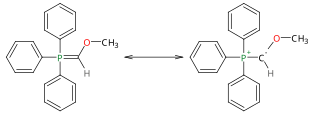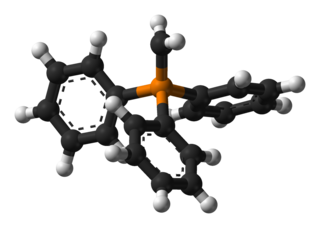In organic chemistry, Wittig reagents are organophosphorus compounds of the formula R3P=CHR', where R is usually phenyl. They are used to convert ketones and aldehydes to alkenes:
In organic chemistry, Wittig reagents are organophosphorus compounds of the formula R3P=CHR', where R is usually phenyl. They are used to convert ketones and aldehydes to alkenes:

Because they typically hydrolyze and oxidize readily, Wittig reagents are prepared using air-free techniques. They are typically generated and used in situ. THF is a typical solvent. Some are sufficiently stable to be sold commercially. [1]
Wittig reagents are usually prepared from a phosphonium salt, which is in turn prepared by the quaternization of triphenylphosphine with an alkyl halide. Wittig reagents are usually derived from a primary alkyl halide. Quaternization of triphenylphosphine with secondary halides is typically inefficient. For this reason, Wittig reagents are rarely used to prepare tetrasubstituted alkenes.
The alkylphosphonium salt is deprotonated with a strong base such as n-butyllithium:
Besides n-butyllithium (nBuLi), other strong bases like sodium and potassium t-butoxide (tBuONa, tBuOK), lithium, sodium and potassium hexamethyldisilazide (LiHMDS, NaHMDS, KHDMS, where HDMS = N(SiMe3)2), or sodium hydride (NaH) are also commonly used. For stabilized Wittig reagents bearing conjugated electron-withdrawing groups, even relatively weak bases like aqueous sodium hydroxide or potassium carbonate can be employed.
![[Ph3PCH3] Br , typical phosphonium salt. Ph3PCH3+Br-.png](http://upload.wikimedia.org/wikipedia/commons/thumb/a/a9/Ph3PCH3%2BBr-.png/134px-Ph3PCH3%2BBr-.png)
The identification of a suitable base is often an important step when optimizing a Wittig reaction. Because phosphonium ylides are seldom isolated, the byproduct(s) generated upon deprotonation essentially plays the role of an additive in a Wittig reaction. As a result, the choice of base has a strong influence on the efficiency and, when applicable, the stereochemical outcome of the Wittig reaction.
Electron-withdrawing groups (EWGs) enhance the ease of deprotonation of phosphonium salts. This behavior is illustrated by the finding that deprotonation of triphenylcarbethoxymethylphosphonium requires only sodium hydroxide. The resulting triphenylcarbethoxymethylenephosphorane is somewhat air-stable. It is however less reactive than ylides lacking EWGs. For example they usually fail to react with ketones, necessitating the use of the Horner–Wadsworth–Emmons reaction as an alternative. Such stabilized ylides usually give rise to an E-alkene product when they react, rather than the more usual Z-alkene.

Wittig reagents are used for olefination reactions, i.e. the Wittig reaction.
Wittig reagents are prepared by deprotonation of alkyl phosphonium salts, and this reaction can be reversed. The methodology can be useful in the preparation of unusual Wittig reagents. [2]
Alkylation of Ph3P=CH2 with a primary alkyl halide R−CH2−X, produces substituted phosphonium salts:
These salts can be deprotonated in the usual way to give Ph3P=CH−CH2R.
Although ylides are "electron-rich", they are susceptible to deprotonation of alkyl substituents. Treatment of Me3PCH2 with butyl lithium affords Me2P(CH2)2Li. [3] Having carbanion-like properties, lithiated ylides function as ligands. Thus Me2P(CH2)2Li is a potential bidentate ligand. [4]
Wittig reagents are usually described as a combination of two resonance structures:
The former is called the ylide form and the latter is called the phosphorane form, which is the more familiar representation.
Crystallographic characterization of methylenetriphenylphosphorane shows that the phosphorus atom is tetrahedral. The PCH2 centre is planar and the P=CH2 distance is 1.661 Å, which is much shorter than the other P-C distances (1.823 Å). [5]

In organic chemistry, an alkene is a hydrocarbon containing a carbon–carbon double bond. The double bond may be internal or in the terminal position. Terminal alkenes are also known as α-olefins.

In organic chemistry, a carboxylic acid is an organic acid that contains a carboxyl group attached to an R-group. The general formula of a carboxylic acid is R−COOH or R−CO2H, with R referring to the alkyl, alkenyl, aryl, or other group. Carboxylic acids occur widely. Important examples include the amino acids and fatty acids. Deprotonation of a carboxylic acid gives a carboxylate anion.
An ylide or ylid is a neutral dipolar molecule containing a formally negatively charged atom (usually a carbanion) directly attached to a heteroatom with a formal positive charge (usually nitrogen, phosphorus or sulfur), and in which both atoms have full octets of electrons. The result can be viewed as a structure in which two adjacent atoms are connected by both a covalent and an ionic bond; normally written X+–Y−. Ylides are thus 1,2-dipolar compounds, and a subclass of zwitterions. They appear in organic chemistry as reagents or reactive intermediates.

In organometallic chemistry, organolithium reagents are chemical compounds that contain carbon–lithium (C–Li) bonds. These reagents are important in organic synthesis, and are frequently used to transfer the organic group or the lithium atom to the substrates in synthetic steps, through nucleophilic addition or simple deprotonation. Organolithium reagents are used in industry as an initiator for anionic polymerization, which leads to the production of various elastomers. They have also been applied in asymmetric synthesis in the pharmaceutical industry. Due to the large difference in electronegativity between the carbon atom and the lithium atom, the C−Li bond is highly ionic. Owing to the polar nature of the C−Li bond, organolithium reagents are good nucleophiles and strong bases. For laboratory organic synthesis, many organolithium reagents are commercially available in solution form. These reagents are highly reactive, and are sometimes pyrophoric.
In polyatomic cations with the chemical formula PR+
4. These cations have tetrahedral structures. The salts are generally colorless or take the color of the anions.

Triphenylphosphine (IUPAC name: triphenylphosphane) is a common organophosphorus compound with the formula P(C6H5)3 and often abbreviated to PPh3 or Ph3P. It is widely used in the synthesis of organic and organometallic compounds. PPh3 exists as relatively air stable, colorless crystals at room temperature. It dissolves in non-polar organic solvents such as benzene and diethyl ether.
The Wittig reaction or Wittig olefination is a chemical reaction of an aldehyde or ketone with a triphenyl phosphonium ylide called a Wittig reagent. Wittig reactions are most commonly used to convert aldehydes and ketones to alkenes. Most often, the Wittig reaction is used to introduce a methylene group using methylenetriphenylphosphorane (Ph3P=CH2). Using this reagent, even a sterically hindered ketone such as camphor can be converted to its methylene derivative.

n-Butyllithium C4H9Li (abbreviated n-BuLi) is an organolithium reagent. It is widely used as a polymerization initiator in the production of elastomers such as polybutadiene or styrene-butadiene-styrene (SBS). Also, it is broadly employed as a strong base (superbase) in the synthesis of organic compounds as in the pharmaceutical industry.

Sodium bis(trimethylsilyl)amide is the organosilicon compound with the formula NaN(Si 3)2. This species, usually called NaHMDS, is a strong base used for deprotonation reactions or base-catalyzed reactions. Its advantages are that it is commercially available as a solid and it is soluble not only in ethers, such as THF or diethyl ether, but also in aromatic solvents, like benzene and toluene by virtue of the lipophilic TMS groups.

The Johnson–Corey–Chaykovsky reaction is a chemical reaction used in organic chemistry for the synthesis of epoxides, aziridines, and cyclopropanes. It was discovered in 1961 by A. William Johnson and developed significantly by E. J. Corey and Michael Chaykovsky. The reaction involves addition of a sulfur ylide to a ketone, aldehyde, imine, or enone to produce the corresponding 3-membered ring. The reaction is diastereoselective favoring trans substitution in the product regardless of the initial stereochemistry. The synthesis of epoxides via this method serves as an important retrosynthetic alternative to the traditional epoxidation reactions of olefins.
The Barton–Kellogg reaction is a coupling reaction between a diazo compound and a thioketone, giving an alkene by way of an episulfide intermediate. The Barton–Kellogg reaction is also known as Barton–Kellogg olefination and Barton olefin synthesis.

The Horner–Wadsworth–Emmons (HWE) reaction is a chemical reaction used in organic chemistry of stabilized phosphonate carbanions with aldehydes to produce predominantly E-alkenes.
Organophosphorus chemistry is the scientific study of the synthesis and properties of organophosphorus compounds, which are organic compounds containing phosphorus. They are used primarily in pest control as an alternative to chlorinated hydrocarbons that persist in the environment. Some organophosphorus compounds are highly effective insecticides, although some are extremely toxic to humans, including sarin and VX nerve agents.

Methoxymethylenetriphenylphosphine is a Wittig reagent used for the homologization of aldehydes, and ketones to extended aldehydes, a organic reaction first reported in 1958. The reagent is generally prepared and used in situ. It has blood-red color, indicative of destabilized ylides.

Diphenylphosphine, also known as diphenylphosphane, is an organophosphorus compound with the formula (C6H5)2PH. This foul-smelling, colorless liquid is easily oxidized in air. It is a precursor to organophosphorus ligands for use as catalysts.
Organosodium chemistry is the chemistry of organometallic compounds containing a carbon to sodium chemical bond. The application of organosodium compounds in chemistry is limited in part due to competition from organolithium compounds, which are commercially available and exhibit more convenient reactivity.

A metal-phosphine complex is a coordination complex containing one or more phosphine ligands. Almost always, the phosphine is an organophosphine of the type R3P (R = alkyl, aryl). Metal phosphine complexes are useful in homogeneous catalysis. Prominent examples of metal phosphine complexes include Wilkinson's catalyst (Rh(PPh3)3Cl), Grubbs' catalyst, and tetrakis(triphenylphosphine)palladium(0).

Methylenetriphenylphosphorane is an organophosphorus compound with the formula Ph3PCH2. It is the parent member of the phosphorus ylides, popularly known as Wittig reagents. It is a highly polar, highly basic species.
Hexaphenylcarbodiphosphorane is the organophosphorus compound with the formula C(PPh3)2 (where Ph = C6H5). It is a yellow, moisture-sensitive solid. The compound is classified as an ylide and as such carries significant negative charge on carbon. It is isoelectronic with bis(triphenylphosphine)iminium. The P-C-P angle is 131°. The compound has attracted attention as an unusual ligand in organometallic chemistry.

Methyltriphenylphosphonium bromide is the organophosphorus compound with the formula [(C6H5)3PCH3]Br. It is the bromide salt of a phosphonium cation. It is a white salt that is soluble in polar organic solvents.